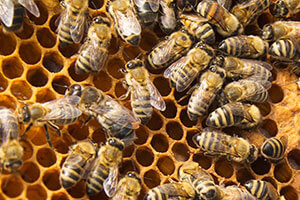
Currently, a third to a half of managed honey bee colonies is lost every winter in Europe (Potts et al. 2010a) and North America (Seitz et al., 2016). This decline in managed honey bees threatens honey production and crop pollination service in many countries (Potts et al. 2016), leading to concerns for negative social, economic and ecological effects (Potts et al. 2010b). Unable to identify the mechanism of the decline, studies suggest that the colony failure comes from interactions between environmental changes, pressure from pest and pathogens and beekeeping management (Potts et al. 2010b, Goulson et al. 2015, Simone-Finstrom et al. 2016). Traditional experimental approaches, i.e. laboratory and field works, have failed to assess multiple interactions, potentially imposed by time limitations (Goulson et al. 2015). To improve and complement these studies, large-scale surveys of honey bee health have emerged around the world.
The surveys of honey bee health around the world
Large-scale surveys of honey bee health are often volunteer-based, created with standardized methods in the form of questionnaires, and diffused to beekeepers (Van der Zee et al. 2013). The aim is to help understanding the current overall decline of honey bees by recording the distribution of colony losses, pests and pathogens. The collected data can be used to assess correlations between colony losses and potential explanatory factors including beekeeping management and the occurrence of pests and pathogens.
North America (vanEngelsdorp et al. 2008, Currie et al. 2010, Seitz et al., 2016), Europe (Chauzat et al. 2016), China, Israël, Turkey (van der Zee et al. 2012) and the Republic of South Africa (Pirk et al. 2013) already have these kinds of honey bee surveys in place. The common trait of all the successful surveys comes from inter-institutional coalitions to build large-scale networks of beekeepers. Such coalitions gave birth to consortiums and partnerships at national and international levels, such as the Bee Informed Partnership in United States (vanEngelsdorp et al. 2008, Seitz et al., 2016), the EPILOBEE consortium in Europe (Chauzat et al. 2016), and the COLOSS Network on a more global scale (van der Zee et al. 2012). South America often lacks strong connections between institutions and networks of organizations, which makes it more difficult to work at national and international levels (Maggi et al. 2016). This continent is consequently one of the few continents where large-scale surveys of honey bee health are lacking (but see Jaffé et al. 2015 for the Brazilian stingless bees survey).
Toward large-scale surveys of honey bee health in South America
South America should be a high priority area for this kind of research, since it encompasses a large gradient of climates, environmental conditions, and beekeeping management, three potential drivers of honey bee decline (Potts et al. 2010b, Goulson et al. 2015). Furthermore, beekeeping provides social as well as economic and ecological benefits, and the decline of honey bees are therefore of great concerns, especially since South America hosts 6.8 million colonies of managed honey bees in Argentina, Brazil, Chile, Uruguay, and Venezuela (Maggi et al. 2016), and contributes to a large part of the honey production and exportation worldwide (FAOSTAT 2016).
We here present an initiative of the first large-scale survey of honey bee health in South America, based in Argentina, which is the largest contributor of both managed honey bee colonies (Maggi et al. 2013), and honey production and exportation (FAOSTAT 2016) in South America. With this new initiative we aim to record the distribution of colony losses, the occurrence of pests and pathogens, as well as beekeeping practices and associated socio-economical values of beekeeping, for the season 2015-2016. This information will be used to model the effects of the different potential drivers of colony losses and map distribution of pests and pathogens in Argentina.
An initiative of volunteers-based survey in Argentina
Our survey is based on international standardized methods (Van der Zee et al. 2013), for which a volunteer-based survey was developed, including a national network of beekeepers, a standardized questionnaire, and various dissemination strategies. To build a network of beekeepers, as well as to have a strong
…


